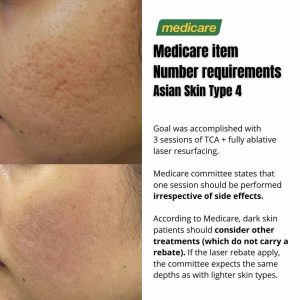Medicare rules for the revision of acne scars; as of September 2022
In late 2022, there was a change in Medicare rebate requirements for the treatment of acne
scars. Please see the points below…
Medicare Facts
- A Medicare rebate applies to most cases of acne scar revision, providing they are in the ‘severe category.’ This is termed grade 4 scarring
- Severe acne scars are measured objectively, namely at conversational distances
- Rebates vary between $67 to $748, based upon the procedure undertaken
- Subcision is partially covered under Medicare
- Fully ablative laser resurfacing must involve the entire aesthetic for the item number to be claimed
- Other Medicare rebate items include steroid injections & excision of scar tissue
- Fractional lasers have NO Medicare rebate
- Procedures such as dermal fillers, collagen stimulating injectables, microneedling & microneedling RF do not carry a Medicare rebate
- Pigment lasers such as Picoway & Picosure do not carry a Medicare rebate
What are the ablative laser guidelines?
Ablative laser; definition as per Medicare guidelines:
‘CARBON DIOXIDE LASER OR ERBIUM LASER (not including fractional laser therapy) resurfacing of the face or neck for severely disfiguring scarring resulting from trauma, burns or acne – limited to 1 aesthetic area.’


- Medicare wants the entire cheek treated – irrespective of the presence of scars, side effects, downtime & risks.
- Fully ablative laser resurfacing must be performed to cover the entire cosmetic unit.
- If scars involve say, 4X 20 cent surface area, the entire cheek must be treated to claim the item number, even if there are areas not involved in scarring.
- Additionally, the laser needs to be of a certain depth not just fully ablative to the upper layers of skin (epidermis & papillary dermis)
- This depth is reflective of the patient’s downtime & expected complication rates such as pigment changes.
This means darker skin patients can ONLY claim the item number IF the depth is the same as white counterparts. They are entitled to a Medicare claim if they are willing to accept the fact that procedures carry a much higher rate of complications.

What can be claimed under Medicare?
The following types of scar revision can be claimed under Medicare–
- Subcision of severe scars
- Fully ablative laser resurfacing
- Steroid injections
- Excision of scar tissue
- Dermal grafting of scars

What about subcision & acne scars?
By definition subcision fall under the item number described by Medicare, namely item number 45510 for scars under 3 cm long; the majority of acne scars.
‘For the purposes of items 45506 to 45518, revision of scar refers to modification of existing scars (traumatic, surgical or pathological) that is designed to decrease scar width, adapt scar position with regard to skin creases and landmarks, release scars from adhering to underlying structures, improve scar contour in keeping with undamaged skin or restore the shape of facial aperture.’
What is the definition of severe acne scars?
Dermatologists’ viewpoint on severity is different from Medicare’s. Severe acne scars, as defined & accepted by procedural dermatologists are ‘grade 4 acne scarring using the Goodman-Baron scale.’
Grade 4 scars: non-distensible scars that cannot be covered up with make up or the normal growth of beard hair in male patients that are visible at conversational distances of at least 50 centimetres.

Medicare director’s viewpoint (2017); scar revision under Medicare maybe claimed if scars are severely disfiguring & impair the function of activities of daily living, namely eating, drinking & talking.
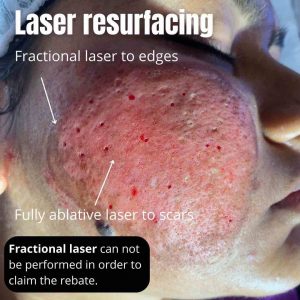
Bottom line, there is a divergent viewpoint on the definition of severe scarring, which has a direct impact on how item numbers can be claimed- both for the initial consultation & repair of skin scars.

View our Treatment Gallery
What has skin colour got to do with things?
Lots. Though I largely agree that an objective scale is important to quantify scar grading, & to date the most widely accepted definition is the Goodman-Baron scale, scar grading needs to be revised. Here are my thoughts on scar grading.

Skin colour needs to be taken into consideration. Dark skin absorbs light, white skin reflects. The same ding on a black car door is more visible than on a white car door. The same applies to acne scars. Visual severity should be graded accordingly. Both in distance & colour. The latter refers to PIH or post-inflammatory hyperpigmentation. PIH, though mostly flat & follows the contour of normal skin (it can be associated with grade 4 atrophic scars, or grade 2), can be devastating to skin of color. In 20% of cases, it can persist beyond 5 years.

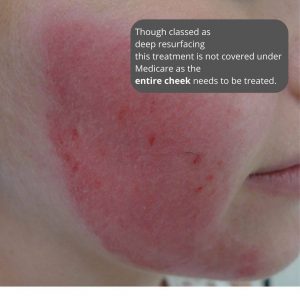
What about darker skin types & acne scar revision?
Medicare ruling, interpretation of item numbers & viewpoint on treating skin of color. Here are the facts-
- Skin of color has deeper & more extensive scars.
- Darker skin absorbs light, light skin reflex. With similar volume changes, dark skin scars appear worse.
- Fully ablative CO2 & or erbium laser can be safely used to treat skin of color provided the settings are appropriate.
- Appropriate settings include less depth as opposed to treating lighter skin types.
- If deeper settings are used, the chances of post laser skin darkening are higher, whilst post treatment lightening (hypopigmentation) heralds a worse outcome.
Here is the item number description by Medicare.

CARBON DIOXIDE LASER OR ERBIUM LASER (not including fractional laser therapy) resurfacing of the face or neck for severely disfiguring scarring resulting from trauma, burns or acne – limited to 1 aesthetic area
Medicare’s interpretation of item number;
- The entire aesthetic area must be treated. On the cheek for example, even if scars occupy 50% of the cheek, the entire skin from under the eyes to in front of the ear MUST be treated, regardless of scarring
- Depth. The depth of skin ranges from 100 to 300+ microns on the cheeks. Thinner close the eye, thicker in the mid-cheek. To claim this item number, depth of full ablative laser resurfacing must be the same as treating white skin, irrespective of race or color of skin.
The correct thing to do is to treat scarring with appropriate methods. Color of skin plays an important role in determining the settings, namely depth & extent.
Appropriate methods include confinement of treatment to scar areas only, reducing potential for complications such as scarring & changes in pigmentation. My mode of practice is to employ fractional lasers to the edges of the treatment zone. This gives a blend to the treated area.
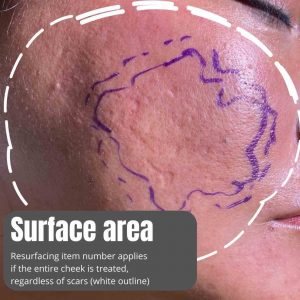
In all cases I perform conservative fully ablative lasers to get into the upper layers of skin. This is adjusted according to the skin type. Fractional lasers are applied to blend & to reach deeper areas of skin. Treatments are hence modified according to skin color.

Medicare committee ruling: If I am concerned about side effects, other treatments that don’t carry an item number should be sought. Their view is that all skin types should be treated with deep resurfacing (as defined by recovery period, reflective of depth).


How to cost effectively treat acne scarring?
Here is how patients can receive effective scar revision bearing costs in mind.
In most cases I can markedly improve scars in one to two ‘big’ sessions.
My mode of practice is to subcise in multi-levels, releasing as much tissue as possible. Laser resurfacing -TCA-excisions-RFM are all conducted in this one session. You may require an additional session or two if-
- You have extensive scarring, example include scars on the temples, forehead & cheeks
- You re-attach scars, most common cause is persistent inflammation due to acne
- Your have active acne, however mild, as this distracts from collagen production
- You wish me to proceed with minimal downtime
From there, I may place you on a revision program by my experienced nursing team in Brisbane, or a colleague in Sydney.
What types of treatments does my nursing team perform?
My senior nurses have been schooled in the treatment of scar revision for nearly 8 years. My senior nurses can-
- Perform deep fractional lasers using erbium, CO2, non-ablative wavelengths
- Perform deep focal peels including TCA Paint & CROSS.
- Perform RF microneedling with various devices.
- Know how to subcise & importantly know when & how to employ soft tissue fillers including collagen stimulating injections.
They provide accurate, safe & effective treatments & are cost effective. This will save patients money & time. I do get involved in the treatment of complex scarring.

What are other treatments we use for scar revision?
After one to two sessions of the above, I transition you to my senior nurses. They provide cost effective & effective treatments including-
- Cannula & saline subcision: Low risk, minimal downtime procedures to break up mild scars.
- Biostimulatory injections of ‘fillers’: by definition, hybrid hyaluronic acid molecules that stimulate your own collagen.
- TCA Paint: for deep ice pick & boxcar acne scars.
- CO2 lasers: using one of 3 devices: best for box car & rolling scars.
- NA Hybrid 1570 or 1550 lasers: for mild scars. This treatment has minimal downtime.
- Manual microneedling: for scar on the forehead & temples
- RF microneedling: for deeper rolling acne scars that require more collagen remodeling; cheeks & jawline
Though widely accepted in the medical literature, the above treatments do not carry a Medicare rebate.
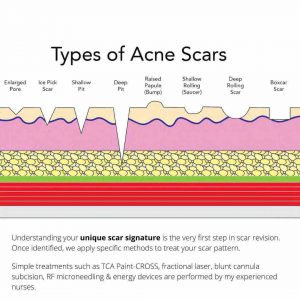
Davin’s Viewpoint on the Medicare rebates & scar revision
What pisses me off with the Medicare process is that the committee members who make decisions on what item numbers can be claimed have no regard for ethnic skin or skin of colour.
The Medicare committee that made these revisions have ZERO experience in laser dermatology, not to mention they have very little experience in treating skin of colour. Irrespective of the fact that the entire panel consist of non-ethnic skin, with little regard for darker skin type. Their interpretation of severity is not reflective of how procedural dermatologist grade acne scars objectively.

On the topic of skin type; for fair skin individuals I can lase (that’s the proper word for laser) deeper, as the chances of skin colour change is less compared to skin type. Providing I treat the ENTIRE cheek (example of one aesthetic unit), a claim may apply. Technically the definition of severe scars is divergent, as the Medicare committee defines this as scarring that causes functional impairment (dribble when you drink, unable to open mouth widely, difficulty with speech; think acne should equal burns patient). In darker skin types, we have to modify the way we lase; namely-
The end point is the papillary dermis, namely more superficial level. Deep level = post inflammatory hypopigmentation as the worse outcome. PIH can be treated quite easily with pico lasers & topicals. Hence the rate limiting factor is skin colour for going deep. Even though the treatment parameters fulfil the Medicare criteria of deep resurfacing, Medicare ‘experts’ say we need to lase to the depth of white skin if the item number for resurfacing is to be claimed. Sh*t like that really pisses me off.

Want some inside information?
Firstly, I am NOT saying that Medicare privileges for lighter skin patients should be cut. I am saying that Medicare rebates for darker skin individuals should be on par with lighter skin types.
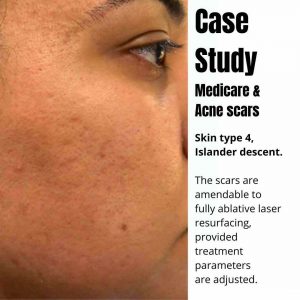

Facts: Lighter skin types will get more skin cancer than darker skin (up to 1000 X more likely). 2 out 3 fair skin Australians will develop non-melanoma skin cancer, over 40% of fair skin individuals will get at least ONE sunspot at aged 40. I get it, we need to treat & screen for cancer in light skin patients. It is proving appropriate health care. Dark skin patients do not tap into this Medicare pool.
Fact: Lighter skin types have much incidence of rosacea. Medicare subsidy applies in most cases, when redness if visible at 3 meters.
Facts: Darker skin type have a much higher rate of PIH or skin darkening. Im most cases it can be seen at distances over 5 meters, & unlike redness, treatment is complex. In over 25% of cases it can last 5 years and beyond. There is no Medicare rebate for this.
.